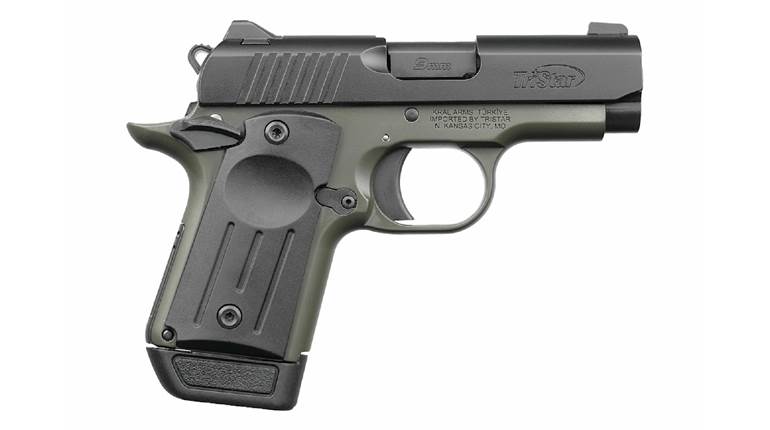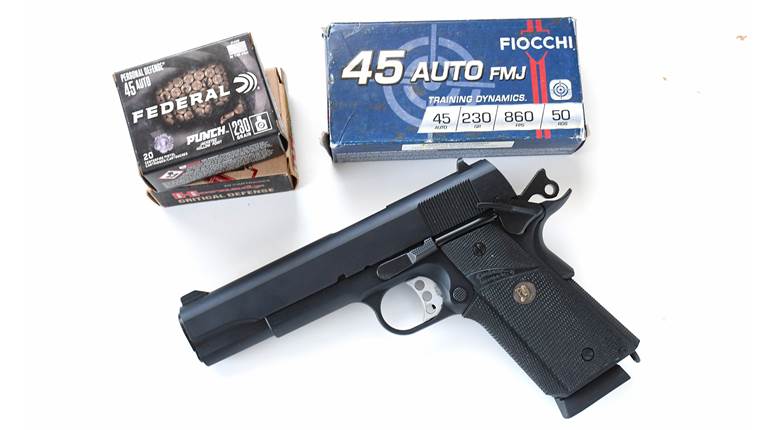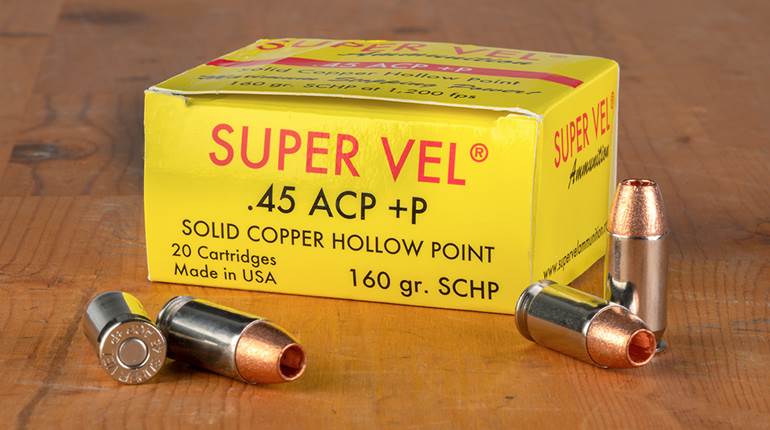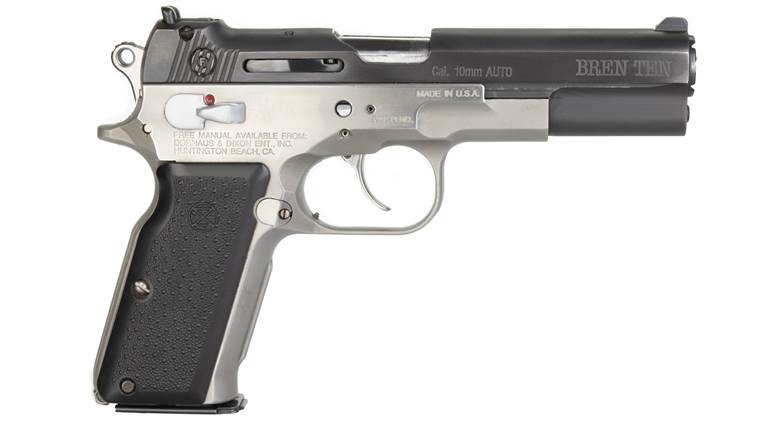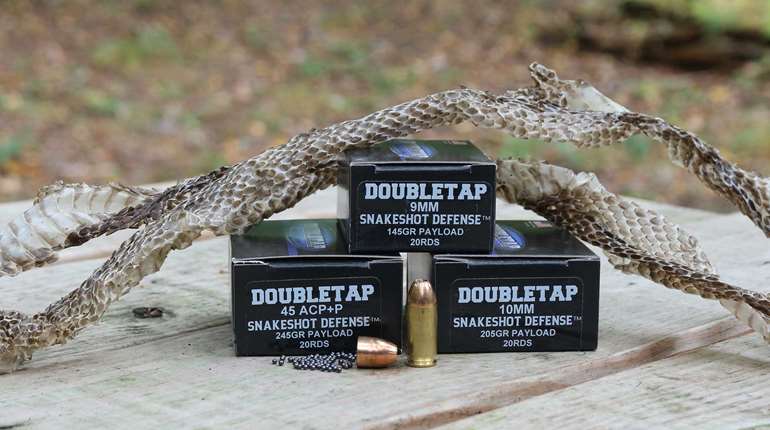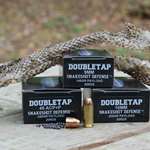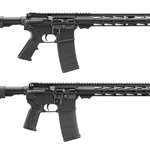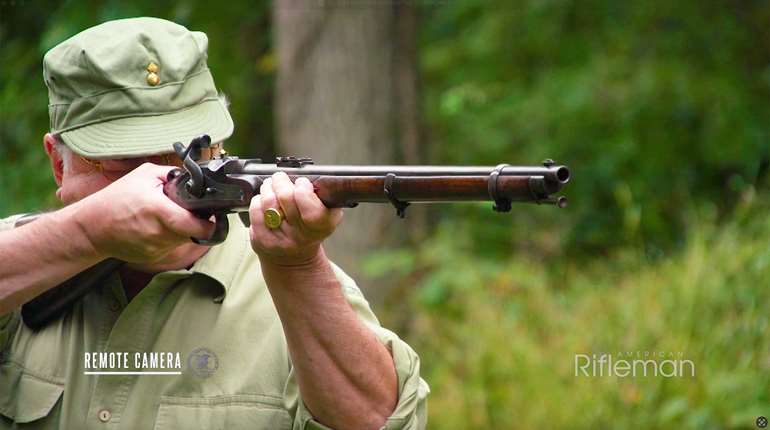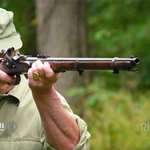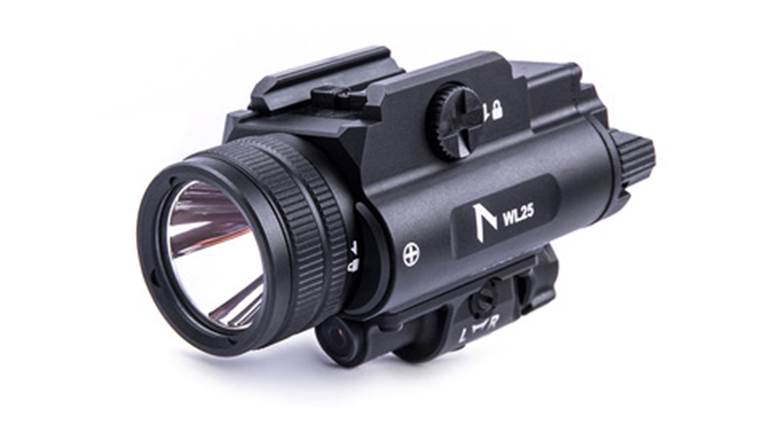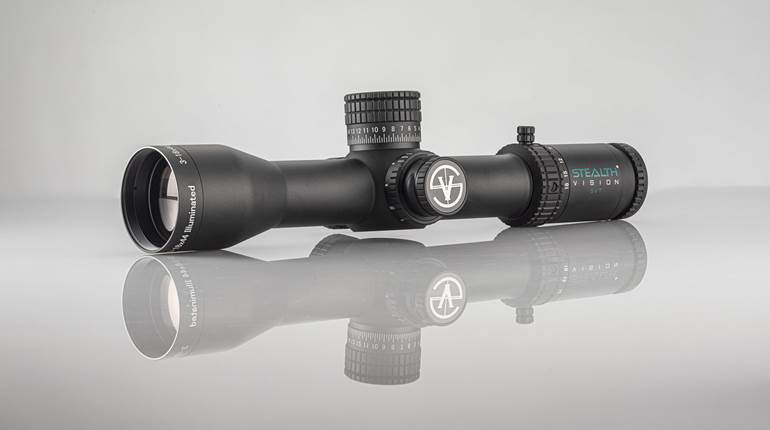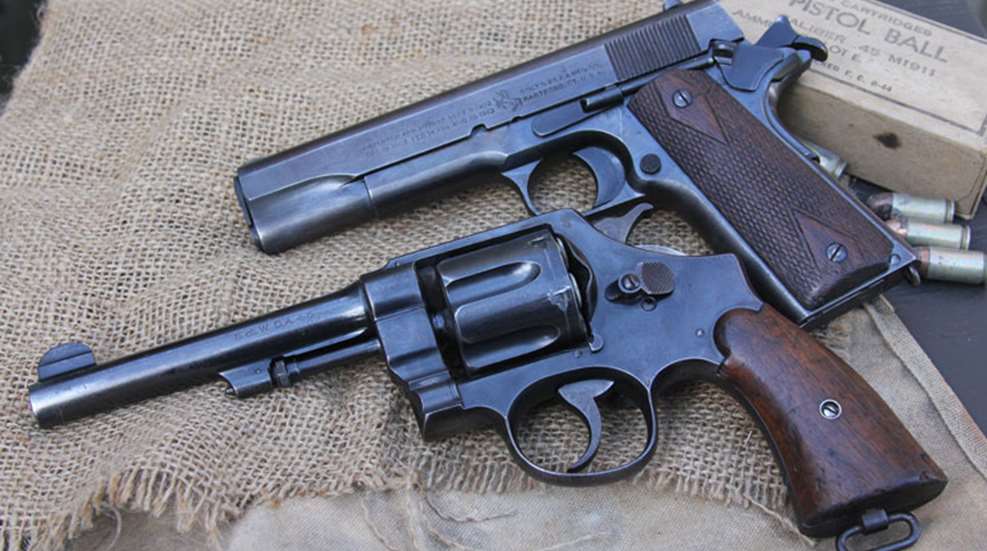
The old “which would you pick ... ?” game is a time-honored diversion among gun folk. I’m talking about the “if you were in (insert era) would you rather have a (insert weapon one) or the model XYZ?” I’ve played this game regularly over the years and it has sparked great debates and found flaws real or imagined in many a classic arm. A perfect example of this is the World War I perennial: The armorer offers you a Colt Automatic Pistol, Caliber .45, M1911 or a Smith & Wesson United States Revolver, Caliber .45, M1917. What do you choose?
First, let me assure you that every military armory that has ever had multiple items or variants to choose from has generated a line of troops wanting to get their hands-on with both in order to carry the “best.” I’ve also seen plenty of men go to great lengths to be the guy who gets to carry something slightly different than his teammates. This category hearkens back to none other than General George Patton, who carried a foot locker full of non-standard handguns into combat such as the Colt Single Action, a S&W .357 Mag., and a Remington Model 51.
Recently I had a chance to settle the 1911/1917 riddle after years of mental shootouts. I ran an example of each through a long list of live fire drills. This was done over an extended period of time and with several hundred rounds each to get data. I approached this question as a modern military man would, firing predominantly from current two-handed techniques in scenarios that would apply in the vintage period while still remaining relevant today.
The Guns
The John Browning designed Colt 1911 needs little introduction as it is the great gran’daddy of a still widely used design that seems more popular than ever heading into its 105th year. The U.S. Army’s Cavalry Board selected the Colt in 1911, with the Navy and Marine Corps following suit shortly after. America’s first autoloading service pistol had already been successfully carried into a number of small wars and expeditions as we headed into the “War to End all Wars” in 1917. As the tiny peacetime military swelled to form the American Expeditionary Force there weren’t enough 1911s to be had. Both Colt and Smith & Wesson had excess manufacturing capacity and suitable large frame revolver designs, so the .45 ACP cartridge was adapted to the New Service and 2d Model .44 Hand Ejector, respectively, and large contracts were signed. With more than 300,000 produced between the two makers, the revolvers weren’t at all uncommon. The rimless .45 ACP cartridge was snapped into a metal “half moon” clip to allow ejection, allowing fast reloading of the guns and the individual rounds headspaced on the case to allow single rounds to be chambered if a doughboy lost or damaged his clips. In that case, ejection was accomplished by a shanks-mare combination of fingernails or poking them out from the front with a twig or rod.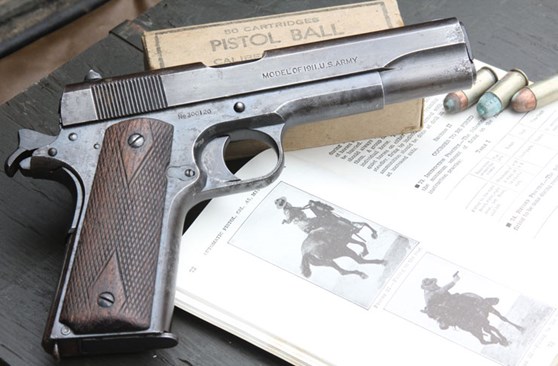
The classic 1911 was actually designed for and initially adopted by the cavalry.
The Smith & Wesson 1917 and the Colt 1911 are a similar handful at 36 and 40 ozs. Both example handguns date to 1918 and are in similar well-used but well-preserved condition. Neither shows arsenal overhaul stamps or refinishing signaling rebuild for reissue in World War II, but many of both types were. The Colt is likely what is known as a “Seabag Special”; the “U.S. Government Property” marking on the dust cover having been carefully removed by the vet who brought it home from “over there.” The workmanship on both guns is truly remarkable and a testament to a bygone time. Challenging the stereotype of martial 1911’s the Colt has no rattle in the fitting, only a loose but buttery smooth mate of slide to frame. Every edge would be considered custom carry melted in today’s market.
Strangely, for an arm that is meant to cock on recoil and be carried on safe, the hammer on the Colt is wide, long and easy to thumb back. This probably represents feedback that Browning received from field tests, keeping in mind that many popular firearms of the period used a half cock notch as a safety. The 1911 was probably carried just that way by some in the early days regardless of how Browning had designed it. An unwelcome side effect of the long hammer spur is that a large handed shooter who chokes up high on the tang as is popular today creates a pinch point between hammer and the original short grip safety. I find this to be an occasional thing that hinders extended practice and not much of an issue inside of a magazine or two.
Even more curious to me than the 1911 having a pronounced and effective hammer is that the 1917 doesn’t have a particularly good hammer spur. In a time frame where revolvers were almost exclusively fired single-action when the situation allowed, the hammer on the big Smith is lacking. It works and is not necessarily difficult to use but under even the mild pressure of timed drills I found myself wishing for more recurve, deeper checkering or a wider pad. I had the hammer slip from under my thumb a couple of times, which is not a deal breaker since I would use the ’17 primarily double action, but odd nonetheless.
The sights on the Colt are humble. That’s being kind. They are significantly worse than the sights found on popular service handguns from the years preceding the Colt’s adoption, so there is really no excuse for them. Just about every Browning designed handgun had terrible tiny notches and dinky overly reflective front sight nubs, so I imagine he had spectacular eyesight and/or a penchant for pointing the arms up close. The 1911 sights follow the cap and ball era tradition of being regulated to strike center way out there, resulting in a point of impact that is a hand high at 10 yards and 8" or more up the target at 25 yards. The tiny sights allow a surprising amount of precision once the shooter figures out the offset hold, but they quickly disappear at speed, against poor contrast, or in anything other than broad, even daylight. To get an idea of just how tiny these things are the typical contemporary service pistol has a front sight about .130”wide. The Colt’s front is about the thickness of a dime at .056”. The entire 1911 sight picture of front and rear notch would fit within the dot on a modern front sight.
By contrast the Model of 1917 sight picture is not particularly great, but is at least not jarringly bad. There is a small amount of light around the front sight in the notch, which lets a shooter break some satisfying slow fire hits, but it makes cycling the heavy double-action pull while trying to keep the sights aligned a challenge. Helpfully, the gentle arc of the topstrap’s end helps point the eye toward centering the front sight even if the shoand keeps the front sight bobbing around the gentle hilltop at speed. The front sight width of .08” is not too far off of thinner competition sights in use today and was visible in a wider range of light and backgrounds than the Colt’s. The Smith strikes comfortably just above the point of aim at 25 yards. 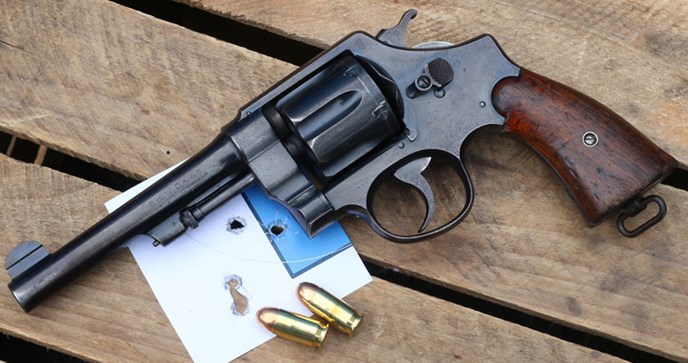
The 1917 is an accurate service gun. Best groups with Winchester hardball look excellent even today.
Triggers … . Here is where preconceived notions head-butt reality. The Colt auto had the original long trigger with a gently rounded face. It was very comfortable and helped in pressing against its 7.75 lb. pull weight. The great 3.5 lb. trigger that many of us associate with the 1911 was not what the cavalry board asked for. The trigger is surprisingly crisp with just a hint of movement and no overtravel. Good work could still be accomplished with the break it provided, but the trigger didn’t give the shooter any “boost.”
Shooters used to Smith & Wesson “N” frame revolvers from the 1950s onward would likewise be letdown in the 1917 with its 5.5-lb. single action and nearly 15-lb. double action. Again, the government specified a “trooper-proof” trigger to curtail accidents. The smooth walnut stocks on the 1917 are skimpy by today’s standards and don’t provide much of an anchor against smoothly pulling through the heavy double action stroke. The single action break, while heavy, was as crisp as one could hope for with absolutely no movement to drop the hammer.
----------------
In casual range comparison the 1917 laps the auto pistol easily. The big revolver has better sights, a nicer trigger, and a respectable level of precision even by today’s standards. Best groups with the 1917 from a barricade at 25 yards ran as little as an inch and a half within a thumb’s length of the point of aim with Winchester 230-gr. FMJ. Most loads typically plopped into 2.5" or less. The best I could squeeze out of the Colt was a bit over 3", again with the Winchester ball, at 25 yards. The usual result with most loads tried was a 4.5" to 6" spread.
There is a healthy bias toward these figures as being conclusive. However, both guns were made with the Great War in full swing and the skilled craftsmen at both factories knew exactly where these guns were going and to what purpose. Both types stayed in inventory for a very long time and were issued side by side with the massive number of 1911A1s for the greatest generation to carry into the Second World War. I thought it would be appropriate to replicate some scenarios that would apply to combat use rather than simple qualification or bragging rights at 25 yards before picking one of the .45’s to slide into my hypothetical holster.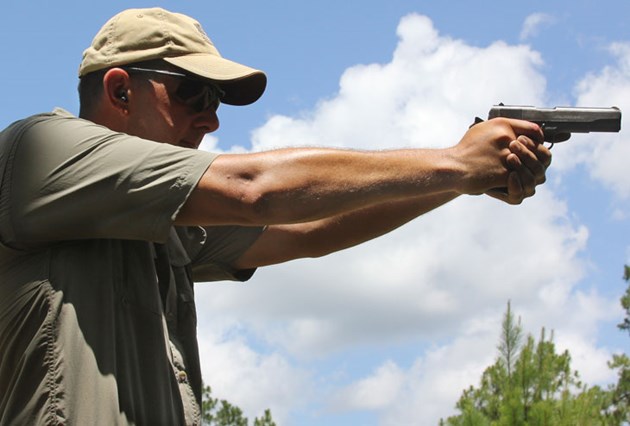
Drills were predominantly fired with contemporary technique to maximize performance.
The first drill was meant to simulate the most urgent use of the handgun, multiple attackers at bayonet distance. Whether in the Argonne Forest, a muddy trench, or a rubbled German alleyway a generation later the ability to stop the enemy at arms’ length gives the sidearm its legitimacy. Three silhouette targets were laid out in a tight echelon at 3, 5 and 7 yards. Starting with both hands on the handgun at chest level the weapons were pushed out at maximum speed and fired; three shots at the closest 3-yard target, two rounds into the target at 5 yards, and a single round into the 7-yard silhouette. The rounds were aimed to impact within an 8” circular vital zone and timed from start signal to sixth shot. Only runs with all the hits within the 8” scoring ring counted for record. This is an up-close drill that emphasizes controllability and how well the gun functions at “fight speed.” The large-frame Smith & Wesson averaged just over three seconds to pump the double action trigger six times and get hits on all three targets. The 1917 bucked with each shot, the 230-gr. ball rolling the barrel high and sending the hump on the tang back hard into the base of the thumb on recoil. Cycling the trigger in as little as a third of a second between shots meant that the issue revolver didn’t have much of a chance to fully recover from the recoil of the previous shot. It took a good bit of effort to ride the recoil see-saw while working the heavy double action stroke and trying to drive the front sight into the target.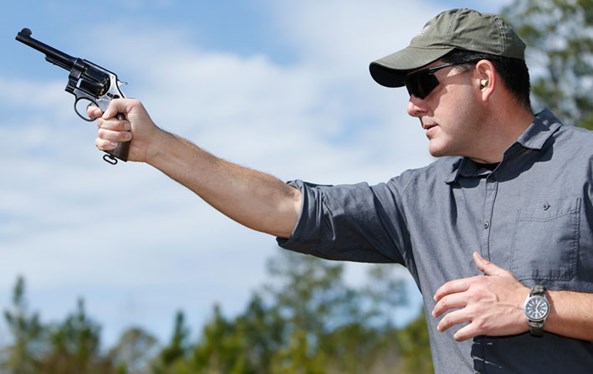
The M1917 in full recoil; the .45 ACP revolver had enough torque to challenge a steady grasp on the smallish stocks.
The 1911 began round chambered, cocked, and with the thumb safety engaged just as the last few 1911-armed units in the Marine Corps carry their descendant Colts today. In as little as 1.75 seconds there were six .45-cal. holes in the targets. Average time across the 1911 runs was 2.1 seconds with 100 percent hits. As an example on one of the runs the first target had been hit three times in just under a second and the second “attacker” struck twice at 1.46 seconds elapsed. Some perspective on relative times: The moderately trained man can work the bolt to reload on period enemy rifles such as the German Mauser in a little under a second and a half. Under stress and with reaction time added in it is likely to take even longer.
3 shots at 3 yards
2 shots at 5 yards
1 shot at 7 yards
High (seconds) Low(seconds) Average(seconds)
M1911 2.45 1.75 2.1
M1917 3.27 2.99 3.02
I next ran the two guns against the plate rack for time at 10 yards. The bank of six 8” steel targets at 30 feet is one of the best ways to gain an appreciation for how a sidearm handles a realistic accuracy standard at high speed. Across every conflict there is a roster of valor awards decorating our troops for bravery against multiple enemy with the handgun. Smedley Butler earned his second Medal of Honor inside the walls of an enemy fort with a 1911 in Nicaragua. Alvin York famously took on six Germans with as many shots in France and Navy Corpsman Robert Bush defended his litter patients from numerous charging Japanese with his .45 on Okinawa. The plate rack isn’t tactical, but it does quickly demonstrate how well a pistol handles multiple targets and provides a direct, repeatable comparison. Black Hills 230-gr. ball was used in this phase in both guns. The Colt auto dropped all plates in as little as 3.6 seconds and 4.01 seconds on average. I’ve spent a fair amount of time with modern service 1911s in similar drills, so this was familiar territory. I had recently fired a custom Wilson Combat/BCM custom 1911 and that highly tuned .45 had allowed me to run the plates in as little as 2.8 seconds. The minuscule sights on the original Colt were a drag on performance here with a slight hesitation per steel plate as I had to hunt for the tiny nub. The 98-year-old Colt handled recoil well and cycled smoothly.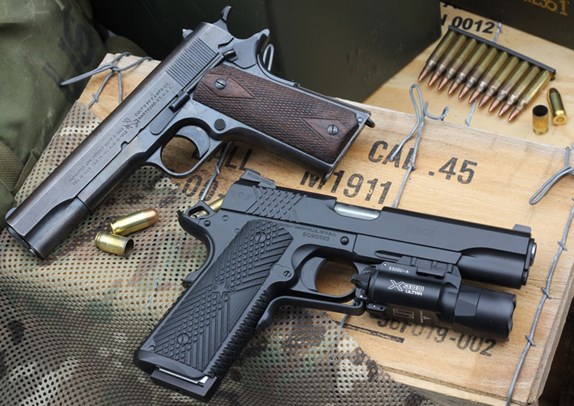
The Colt veteran is a worthy forefather of current hard duty custom 1911s like this Wilson Combat/BCM Gunfighter 1911.
The 1917 got down as low as 4 seconds to clear the rack and averaged 4.57. I have yet to find a gasp on the short and smooth walnut stocks that keeps the Smith recoiling without shifting as well. The revolver's better sights were evident at this distance but offset in overall performance by the scant grip panels.
Six 8” steel plates from
ready at 10 yards High (seconds) Low(seconds) Average(seconds)
M1911 4.36 3.62 4.01
M1917 5.07 4.0 4.57
The handgun is primarily a defensive tool and much of combat occurs at remarkably close ranges, but the battlefield is a chaotic place. Every soldier or Marine carrying the short gun wants to have some capability to reach out and engage the enemy at a distance when required. I set up a 10 x 20 inch steel RSR torso target at 40 yards and logged times and hits for single shots from the ready. 40 yards is a long way in pistol land, but a “gimme” shot for even a conscript rifleman and a very dangerous place to be. The 1917 was in its element when I thumbed the hammer back as I extended the gun and fired single action, rewarding me with nearly 100 percent hits in 2.9 seconds on average. However, 2.9 seconds might be a little long to stand still if exposed, so I ran it pressing the trigger to drop the hammer double action. Times dropped to 2.3 seconds but hit ratio dipped as well.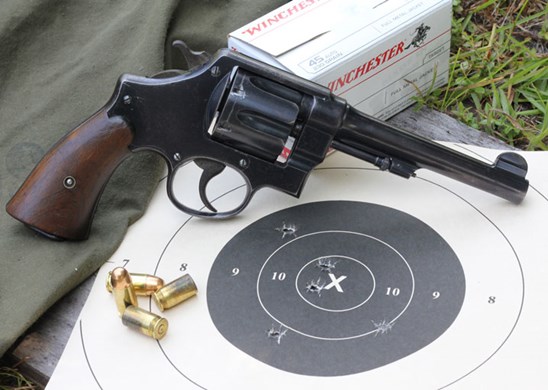
The Smith & Wesson leads in casual comparison with easy groups in the black on standard target centers.
The Colt genuinely surprised me here. The tight target demanded a hard front sight focus and the otherwise poor 1911 sights were so fine that they worked well in this application. One must account for the significant rise of the bullet with the sights’ regulation and I held at the bottom of the RSR target to strike center. Hits came in as little as 1.07 when everything came together ideally and 1.99 seconds on average. Hit ratio was 83 percent. As I stepped back to 40 yards I would not have expected to connect as consistently as I did given the Colt’s 25-yard grouping performance. However the data was built on a large number of shots over multiple range days and remained consistent. I ran the drill with a tuned Glock 17 and an accurate Hornady match load to get an idea of how far off the guns were from contemporary designs and the average was 1.1 seconds to ring the steel, showing the 1911 was remarkably close on its better runs its sights and heavy trigger notwithstanding.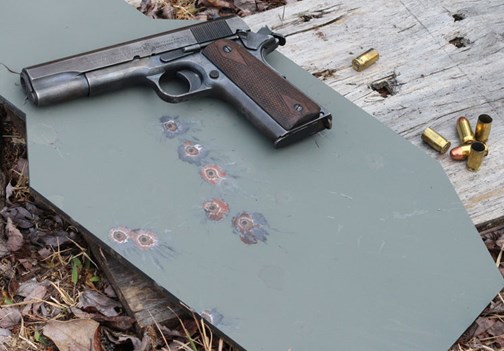
The 98-year-old Colt laid down surprising speed and accuracy at 40 yards on the RSR 10X20 inch torso.
Single shot to 10 X 20”
torso from ready at
40 yards High (seconds) Low(seconds) Average(seconds) Hit ratio
M1911 3.07 1.07 1.99 83%
M1917
Single Action 5.23 2.01 2.90 95%
M1917
Double Action 3.68 1.33 2.33 76%
As a representative nod to how our fighting men would have likely fired the sidearms I set up one final drill. I carried the .45s in my right hand with the muzzle slightly elevated and faced 90 degrees from an 8” target at seven yards. Pivoting at the signal, I turned toward the target and quickly fired two rounds. The 1917 pointed easily over its crescent shaped front sight and the time to trigger a shot into the circle and follow up with another averaged just under two seconds. Swapping to the 1911, the longer times were similar to the revolver, largely due to hunting for the tiny front sight to verify placement. When I turned up the “heat” and took very little verification from the sights the two shots broke a half second plus faster.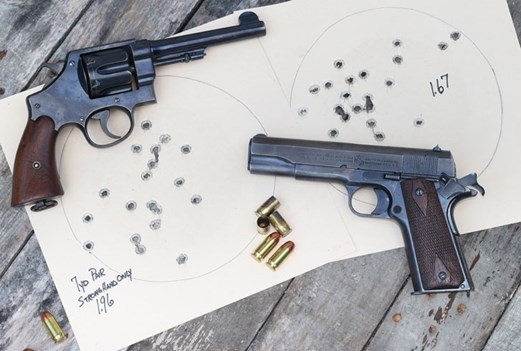
Targets show the results of pivoting to fire a pair of shots with the strong hand at 7 yards.
90 degree pivot to fire
2 shots to 7 yard target
strong hand only High (seconds) Low (seconds) Average (seconds)
M1911 2.0 1.40 1.67
M1917 2.31 1.76 1.96
There you have it. You can review the tables and consider if the results tip you one way or another. I had often suspected that despite having worn a modern issue 1911 overseas that I might prefer the 1917 to the archetype auto. Casual shooting reinforced that notion. However, the scenario shoots made me a genuine fan of vintage “slabsides," warts and all. I would pick the 1911 and step out smartly. The large frame Smith & Wesson was still a very solid substitute and a viable performer. While I wouldn't willingly choose either in a situation today, I’m confident that both could still be pressed into emergency service and carry the day.












